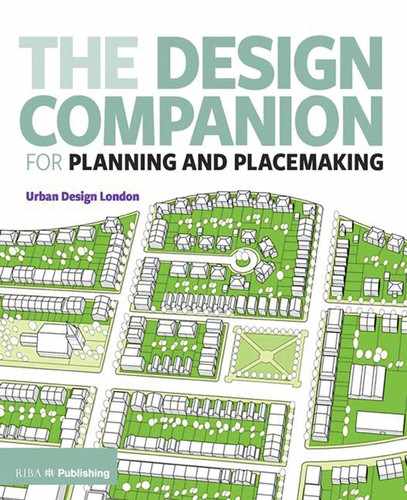14
Public spaces
This chapter focuses on the sorts of spaces that we typically know as squares, but which range in form from informal street corners to grand civic set pieces.
At the larger scale, such spaces have long had an important role as the perceived centres of settlements of all types, and as the focus for public life, activities and events. At smaller scales they might simply be somewhere to rest, hang out or play, and they can provide a visual pause in the flow of streets through urban areas. They are a very important type of space for planners, often being altered or newly created through planning applications.
Since the 1980s the formal urban square has witnessed a renaissance. It has increasingly become an important component of many regeneration and development schemes (both residential and commercial), with far-reaching impacts on how the resulting places are perceived and used. In such a context it is important to design public spaces well, although unfortunately this ambition is often not achieved. However, when we do get them right, high-quality public spaces offer huge economic, social and environmental benefits. This chapter draws on recent research to offer advice on how planners should consider and influence the design of space.
Formal and Informal Spaces
Public spaces require something in their physical form that allows us to distinguish them from their surroundings as a clear and identifiable space. In formal public spaces this is typically a sense of enclosure, where the buildings and landscape first open up to create a space, and second, wrap around the space in order to hold the eye and create a distinct place.
A strong sense of enclosure does not always have to be created anew, and it is not always necessary. Increasingly, very successful, more informal local spaces have been created by simply reclaiming small parcels of street parking or roadway from vehicles, or by paving over the end of a street to create a pause in the urban fabric and an informal space for pedestrians (see Figure 14.1).
Other spaces have been given new character and purpose by granting temporary use rights, perhaps for a market, or have even been created as spaces on a temporary or occasional basis, through actions as simple as painting markings on a road or repurposing a car park. More dramatically, recent years have also seen the character of many long-established squares changing, often significantly, as a result of traffic calming and public-realm improvements (see Figure 14.2).
These sorts of informal spaces are helping to transform many areas. They may not need planning permission, or be included in a masterplan, but planners have an important role in creating and protecting them. Planners will need to be flexible enough to understand and embrace the evolving nature of public space, and to be mindful of the important role of other public-sector agencies in helping to shape spaces, coordinating policy and practices in order to optimise outcomes.
Planners can find themselves dealing with proposals for new spaces within major development schemes. They will also have an interest in the creation, amount and quality of many other spaces that will have an impact on the nature and quality of areas, and their ability to accommodate change and increased populations.
Ways of influencing public spaces include these four forms of regulation:
- Planning controls to sanction new public-space proposals, or where changes of use or alterations
to the (non-highways related) built fabric occur in existing spaces.

Figure 14.1 This new incidental space at Windrush Square reclaims part of the road carriageway to establish an important new hub for social life in the heart of Brixton, London.
- Highways orders, focusing on changes to highways themselves (including stopping up existing rights of way).
- Listed building consents, for changes to the historic (listed) built fabric, a category into which many existing public spaces fall.
- Street trading licensing, where a proposal involves uses concerned with selling goods or services in public space.
Diverse Public Space
Towns and cities should be for everyone, but not every public space will, or should, cater equally for every citizen or for every occasion. Public spaces take on different flavours as a result of the different groups of interests that create them and the particular range of uses they are intended to accommodate. Some spaces can be lively and commercial, while others focus on play (for both children and adults). Others might be serious, civic, peaceful or relaxing. A good example of this is the series of public spaces in central Birmingham, two of which are shown in Figure 14.3. All of the new and regenerated public spaces in Birmingham have different characters and qualities, and accommodate different types of function. Collectively they have helped to transform perceptions of the city.
The variety of public spaces recognises the diversity of lifestyles, preferences and needs among populations, and the fact that the design of their public realm presents the opportunity for areas to offer something for everyone in the right locations (although not necessarily everything for everyone everywhere). In this respect, the public spaces of a town or city can be planned in a strategic sense just as the buildings can, with care taken to ensure that all sections of the community are catered for; that spaces are provided in locations that avoid conflict (such as that between skateboarders and commercial interests, or between revellers and householders); and that they are safe, convenient and inviting to use.
The design of any public space should be a direct response to its context; making it specific to the place requires a great deal of observation and analysis. Different activities within the space can be inspired by the surrounding buildings (and their uses) and by the features of the space – all of which influence its character.
Free Public Space
Ultimately the rights and responsibilities associated with spaces, and what this implies about how public they are, are more important than who owns and manages them. Public spaces are owned and managed through multiple complex arrangements, many of which are not clearly either public or private, while all spaces have some restrictions on use, regardless of ownership. Yet underpinning the notion of ‘public’ space is the idea that, as far as possible, they should be ‘free’ in three senses of the word: open, unrestricted and gratis. Such guaranteed freedoms of use are best established through clearly setting out guaranteed rights and responsibilities for users and owners alike.
This does not always happen, and particular problems occur when owners and managers seek to exclude certain groups (such as teenagers), restrict access (for example at night) or impose codes of behaviour that go beyond societal norms (including banning photography). While these sorts of behaviours are not widespread, when they occur they undermine the freedoms that public space users rightfully expect.
For planners, it is vital to consider these long-term management issues at the same time as shorter-term
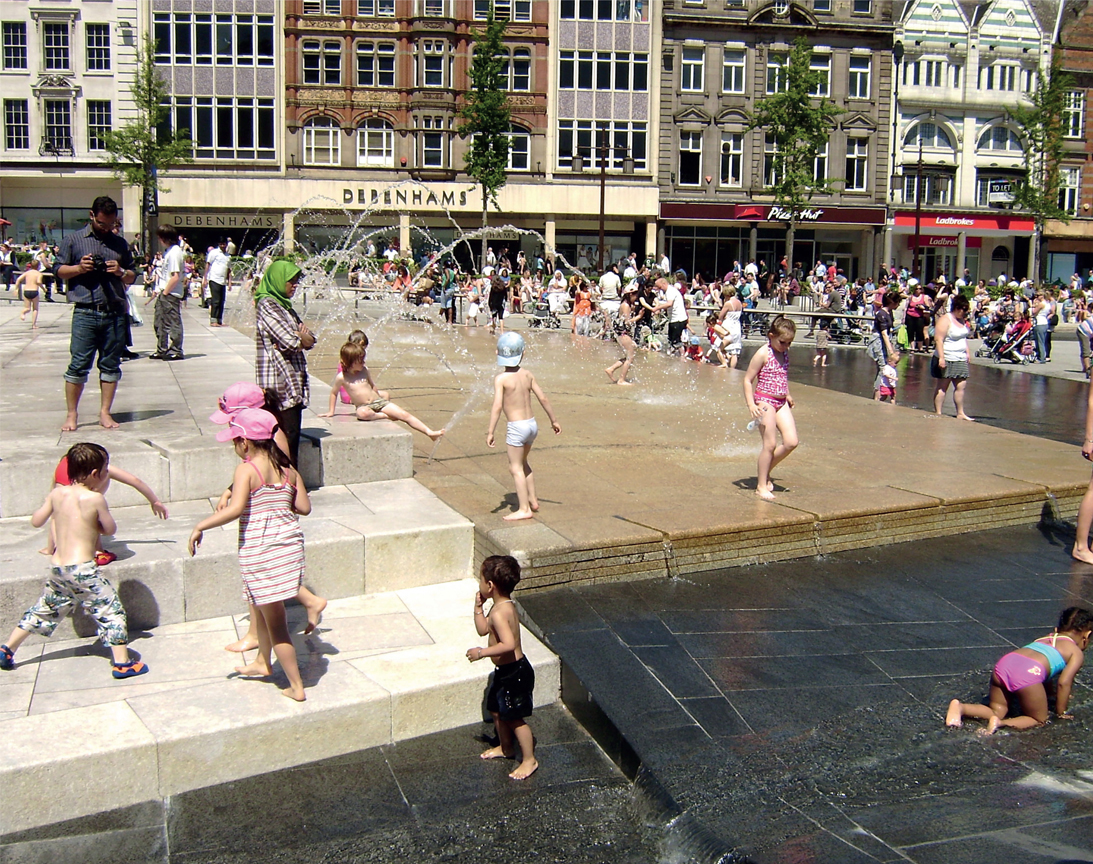
Figure 14.2
Market Square, Nottingham: a dramatic redesign of the city’s historic central square has transformed it into a lively centre of community life.
concerns about quality. If rights and responsibilities are not specified when planning permission is given, they are unlikely to be tied down afterwards. To achieve this, local authorities should adopt a charter of public space rights and responsibilities in policy, or as a standard condition to any planning permission related to new or regenerated public spaces. Sample wording for such a charter is given in the box below.

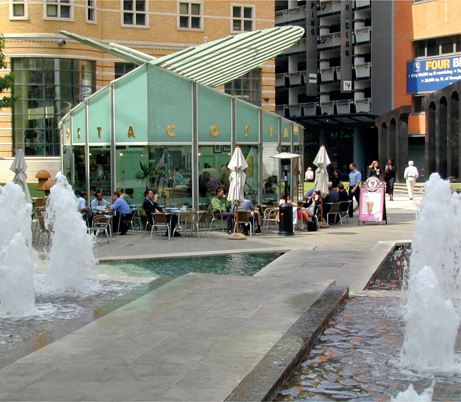
Figures 14.3.1 and 14.3.2
Victoria Square (left) and Brindleyplace, Birmingham (right). The new and regenerated public spaces in this sequence in Birmingham city centre each have different characters and qualities, and accommodate different types of function. Collectively they have helped to transform perceptions of the city.
Sample Charter of Public Space Rights and Responsibilities
All users of public space have the right to do the following:
- Roam freely
- Rest and relax
- Associate with others
- Use public space in a lawful manner without the imposition of local controls unless strictly justified, for example on drinking, smoking, cycling, skating and dog walking
- Collect for registered charities
- Take photographs
- Trade (if granted a public licence)
- Demonstrate peacefully and campaign politically
- Busk or otherwise perform
(in appropriate non-residential locations)
Users of public space have a responsibility to do the following:
- Respect the rights of others to conduct their business without let or hindrance
- Respect public and private property
- Act in a civil and safe manner at all times
- Avoid littering
- Keep the peace
Owners and managers of public space have a responsibility to do the following:
- Respect and protect the rights of all users, including to privacy
- Treat all users in an equitable and inclusive manner
- Keep spaces safe within the context of the actions of any reasonable person
- Keep spaces clean and well maintained
- Keep spaces open and unrestricted at all times (or otherwise in line with regulations)

Figure 14.4
Tower Place, City of London. Here a new public space extends from between the two new buildings and out into an open area alongside the church of All Hallows of the Tower. The presence of a glazed roof over part of this space, the obvious corporate nature of the buildings and the heavy presence of security guards undermine any sense of this being a public space. As a result it is not clear whether or not the general public is allowed into the space.
Designing Public Spaces
Whether through plans, frameworks and policies, or through development management negotiations, planners have the opportunity to set out and implement clear principles for public spaces. While every public space will be different, it is possible to consider some critical factors that are likely to be important:
- How public spaces are clearly delineated from private ones so that they feel, and are, publicly accessible
- How the uses surrounding public spaces contribute to creating engaging places for users
- How spaces can be made more meaningful through the amenities and features they host
- How the opportunity is taken to maximise the potential for a positive social environment in public space
- How a balance between vehicles, pedestrians and other users in public space is set and safeguarded
- How comfortable spaces feel through their ability to foster safe and relaxing uses
- How robust public spaces are through their ability to adapt to changing demands across time, while remaining distinctive
The remainder of this chapter takes these factors in turn, suggesting in more detail why they are important and which aspects planners might consider.
Delineated (clearly public, or clearly private)
If it is unclear who is allowed to go where, spaces can become unloved and underused. This is a matter not just of ensuring free and equal access, but also of recognising that in the wrong places public spaces can be more problematic than if they were absent altogether, and that private spaces for relaxation (such as private or communal gardens) have an important but quite distinct role, too.
The basic principle is that legitimate use should be intuitive: it should be clear to everyone that a space is, for example, a private garden, or a public playground. Boundary treatments, entrances, materials and the facilities within the space can all help to make its intended use clear. In the example shown in Figure 14.4, a new public space extends from between the two new buildings and out into an open area alongside the church of All Hallows-by-the-Tower in the City of London. The presence of a glazed roof over part of this space, the obvious corporate nature of the buildings and the heavy presence of security guards undermine the sense of this being a public space. It is not clear whether the general public is allowed into the space or not. These are all features that should have been avoided.
Public spaces can be intimate and quiet, but their scale and styles of furniture are unlikely to be domestic. They should almost always have recognisably open, or openable, entrances.

Figure 14.5
Concert Square, Liverpool is surrounded by active uses. While sometimes viewed as a place of excess, it forms a natural and recognisable hub for Liverpool’s buzzing nightlife.
Engaging (designing in active uses)
While buildings, landscape and infrastructure define the physical limits of external public spaces, the land uses of spaces will dictate their character: whether peaceful, gently animated or full of life. At all times it is important to be realistic about what will or will not work in particular locations. It may be unrealistic, and inappropriate, to try to create a lively commercial hub in a quiet residential area or a peaceful oasis in a busy urban centre.
Much of the buzz associated with particularly active spaces, for example, will tend to be wrapped up in activities of consumption of one sort or another: activities such as shopping, cafes, markets and so forth (see Figure 14.5). If the intention is to create such a space, active uses should be carefully designed in to the buildings and spaces from the start. These are decisions in which planners almost always play a leading role.
Meaningful (incorporating amenities and features)
Spaces become more meaningful over time as users interact with them and they acquire the patina of age and use. Spaces can also become more meaningful by incorporating important historic or landscape features (such as historic buildings or mature trees), and by hosting other amenities and features with which users can directly engage.
These might be active, such as big screens, bandstands, kiosks, sports facilities, fountains, paddling pools, play equipment, skating opportunities, stages, amphitheatres or lighting displays. Equally they might be restful, serious or contemplative, such as public art displays, sculptural furniture, memorials and monuments, reflecting pools, flower gardens and displays, or Wi-Fi hotspots. Figure 14.6 shows new public space at the heart of the redevelopment of the former Kings Cross railway lands, incorporating a range of new sub-spaces. These include a space facing the Regent’s Canal, which uses the slope and southerly aspect to create a quiet seating area, and more active spaces that set off the buildings of the historic goods yard, where water jets, fountains and lighting help to animate the space.
Social (encouraging social engagement)
The design of public spaces can make them more or less conducive to social interactions of all types, from large-scale events and festivities, to friends meeting for a chat, and everything in between. Providing large uncluttered spaces and more intimate areas offers opportunities for different types of social activity. If particular events are expected, their needs should be planned for from the outset. For example, pop-up broadcasting hubs under Leicester Square in London come into use on the occasion of film premieres, but they lie unnoticed under people’s feet at all other times.
Movement in public space flows mainly along dominant corridors or desire lines, passing right through spaces, and

Figure 14.6
Granary Square, Kings Cross, London. The public space at the heart of the redevelopment of the former Kings Cross Railway Lands incorporates a range of new sub-spaces, including those facing the Regents Canal and setting off the buildings of the historic goods yard, where water jets, fountains and lighting help to animate the space.
Figure 14.7 Poundbury, Dorchester. This largely residential extension to Dorchester features a series of public spaces at its heart. Some are formal and some incidental, such as here where the space is gently animated by the presence of a cafe, and by movement along a clear desire line through the space from a neighbouring square.
from these corridors to active uses within the space (see Figure 14.7). It can be like an invisible mesh of streets and rooms without walls, and the movement eddies create quiet spots between them. Sometimes designs can build on these, raising or lowering areas, and using plants, seats, lighting, water, artworks or surface materials to highlight the character and support the use of different areas.
This largely residential extension to Dorchester features a series of public spaces at its heart. Some are formal and some incidental, such as here where the space is gently animated by the presence of a cafe, and by movement along a clear desire line through the space from a neighbouring square.
If large enough, individual spaces can also work successfully as a series of distinct and separate smaller spaces, each with a different character and purpose, and designed to attract different sorts of users (fountains for children, steps and ramps for skateboarders, alcoves for quiet conversation, and so on). In designing public space it is important to consider the desired social outcomes, and how the physical space and its context will or will not support them. While particular social outcomes can never be guaranteed, leaving them entirely to chance is rarely a successful strategy.
Balanced (between traffic and pedestrians)
The challenge of traffic dominance is a perennial problem that continues to blight many public spaces. The solution, however, does not have to be banning all traffic. Instead a subtle rebalancing of space is often all that is required (see Figure 14.8). Traffic and pedestrians can harmoniously share public space with mutual benefits to both groups: allowing drivers direct access to and between important urban centres, and providing a background level of animation and surveillance in public spaces. This requires that enough space is given to pedestrians for movement and socialisation; that they are not corralled and kettled, but trusted to move and navigate freely; and, to enable this, that traffic is slowed sufficiently on roads leading into and through public spaces.
This space on Bristol’s Floating Harbour is also on the busy A4 trunk road through the city. While traffic still flows along both long sides of the space, the centre has been redesigned as a distinctive new sanctuary for pedestrians and as a more civilised setting for the range of active uses that surround the space.
Comfortable (safe and relaxing)
Ultimately the objective should be the wellbeing of users, and their ability to use spaces in a relaxed and comfortable manner. Safety is promoted by preventing accidents, as well as by discouraging crime and the fear of crime. Busy spaces will always seem safer than deserted ones in terms of crime, as will spaces that are well overlooked and clearly visible from the outside. Spaces that are clean, tidy and well maintained will also seem safer.
Spaces should be relaxing, with opportunities to stop and linger, for example with comfortable and preferably moveable formal seating, informal places to sit (on steps, kerbs and walls – see Figure 14.9), toilet facilities, soft landscaping and careful consideration given to microclimate (places to sit in the sun, and to shelter from the wind and the rain). Grass, for example, while requiring active maintenance, is popular because it is comfortable and flexible, and allows users to position themselves to take advantage of microclimatic conditions. It is highly conducive to relaxation, play and social engagement.
The complete redesign of this space has transformed it from being sad and largely abandoned to being an active place for Woolwich’s diverse communities. In the summer it fills with people who sit, lounge and play on and around the grass, and sometimes watch the big screen.

Figure 14.8
Broad Quay, Bristol: This space on Bristol’s Floating Harbour is also on the busy A4 trunk road though the city, but whist traffic still flows along both long sides of the space, the centre has been redesigned as a distinctive new sanctuary for pedestrians and as a more civilised setting for the range of active uses that surround the space.
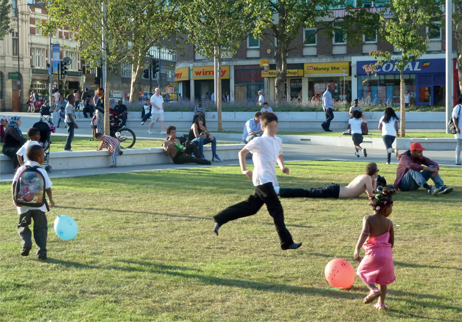
Figure 14.9 General Gordon Square, Woolwich, London. The complete redesign of this space has transformed it from being sad and largely abandoned to being an active place for the diverse communities that live in Woolwich. In the summer it fills with people who sit, lounge and play on and around the grass, and sometimes watch the big screen.
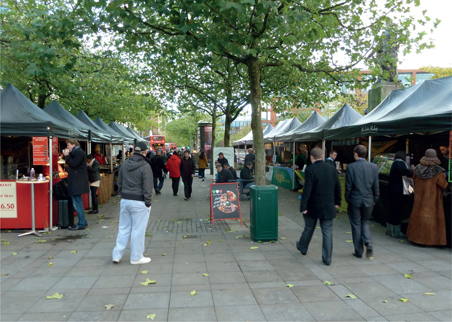
Figure 14.10 Piccadilly Gardens, Manchester: this part of Manchester has long acted as a public transport hub, but the creation of a large partly turfed and partly paved square turned a purely functional space into an adaptable multi-purpose place capable of hosing different events throughout the year, alongside the busses and trams. Here the space is hosting a street food market in one corner of the space.
Robust (adaptable and distinct)
The success of public spaces will depend on shaping places which, through their robust design (simple, uncluttered and with resilient natural materials, trees and planting) and background level of activity, are able to adapt and change over time in a manner that can withstand pressures of homogenisation and yet still feel distinct, welcoming and rooted in the local context.
In the short term, this means spaces that can adapt to different uses and activities, perhaps at different times of the day (such as somewhere for workers to lunch, for children to play after school, or for strolling in the evening); throughout the week (such as a market on a Monday and, without feeling deserted, peace and quiet on a Sunday); or across the year (such as concerts in the summer and ice skating in the winter). This part of Manchester has long acted as a public transport hub (see Figure 14.10), but the creation of a large, partly turfed and partly paved square turned a purely functional space into an adaptable multi-purpose place capable of hosting a variety of events throughout the year, alongside the buses and trams. One corner of the space regularly hosts a street-food market as shown in the figure.
In the long term, a robust space will adapt successfully to changes in the uses that surround the space, or to the demands imposed by unpredictable social and technological change. Robust design solutions will reflect the realities of management routines and the budgets available for upkeep, enabling features to age gracefully and timelessly.
Points to Note
- The best public spaces are those that do not try too hard. Over-design is a frequent and fatal flaw. Think about how people would want to use the space and ensure that this is the starting point for any design, rather than trying to make a statement or make a design different for its own sake.
- Seats with backs are essential for the comfort of older users of public space. Make sure there are enough seats, in spots people want to rest in. As well as formal seats that should work for all, good designs sometimes incorporate informal sitting spots, perhaps on walls, steps or the edge of planters. These look fine when not used and add to the capacity of the area when needed.
- Design permissive spaces that encourage positive uses of all types, rather than restrictive spaces that seek to limit use. This means taking a pragmatic view as to what people will want to use the space for and building in the facilities to make this work, rather than relying on barriers, signs and other hardware to stop uses that will probably happen anyway.
- Think about what a space will be like on a cold, wet and windy winter day, and ensure that there is something to sustain its character and quality all year round. This might mean ensuring that lighting and the uses of the buildings help to bring the place alive and give it purpose when the weather is bad.
